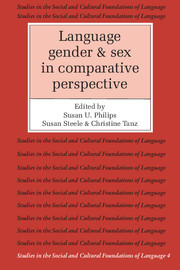Book contents
- Frontmatter
- Contents
- Acknowledgments
- List of contributors
- Introduction: The interaction of social and biological processes in women's and men's speech
- Part I Women's and men's speech in cross-cultural perspective
- Introduction
- 1 The womanly woman: manipulation of stereotypical and nonstereotypical features of Japanese female speech
- 2 The impact of stratification and socialization on men's and women's speech in Western Samoa
- 3 The interaction of variable syntax and discourse structure in women's and men's speech
- 4 A diversity of voices: men's and women's speech in ethnographic perspective
- 5 Women's speech in modern Mexicano
- Part II Gender differences in the language of children
- Part III Sex differences in language and the brain
- References
- Index
4 - A diversity of voices: men's and women's speech in ethnographic perspective
Published online by Cambridge University Press: 05 June 2012
- Frontmatter
- Contents
- Acknowledgments
- List of contributors
- Introduction: The interaction of social and biological processes in women's and men's speech
- Part I Women's and men's speech in cross-cultural perspective
- Introduction
- 1 The womanly woman: manipulation of stereotypical and nonstereotypical features of Japanese female speech
- 2 The impact of stratification and socialization on men's and women's speech in Western Samoa
- 3 The interaction of variable syntax and discourse structure in women's and men's speech
- 4 A diversity of voices: men's and women's speech in ethnographic perspective
- 5 Women's speech in modern Mexicano
- Part II Gender differences in the language of children
- Part III Sex differences in language and the brain
- References
- Index
Summary
The purpose of this chapter is to discuss men's and women's speech from an ethnographic perspective, with a focus on the speaking practices of the Kuna Indians of Panama, among whom I have carried out field research. As I thought about men's and women's speech among the Kuna I found it useful, in fact necessary, to place what I knew about the Kuna in the context of the growing linguistic, sociolinguistic, anthropological, and folkloristic literature on women in relation to language, culture, and society. In order to provide a background for my discussion of the Kuna, then, I first propose a brief overview, based on existing literature, of the types of relationships that exist between men's and women's speech around the world. In the case of the Kuna these relationships are manifested primarily in verbal genres, speaking roles, and ways and patterns of speaking. There are overlaps as well as sharply marked differences in men's and women's speaking practices. Whereas men at one level seem to control and perform most political and ritual activities through public and formalized speaking and chanting, women are also involved in significant ways. In addition women uniquely perform verbal genres that are important in Kuna social and cultural life. Furthermore, from the point of view of the ethnography of communication and of symbolic forms more generally, the molas (reverse appliqué cloth blouses) made, worn, and sold by women are probably the primary marker of Kuna ethnicity and culture, as well as being of social and economic significance.
- Type
- Chapter
- Information
- Language, Gender, and Sex in Comparative Perspective , pp. 95 - 120Publisher: Cambridge University PressPrint publication year: 1987
- 31
- Cited by



